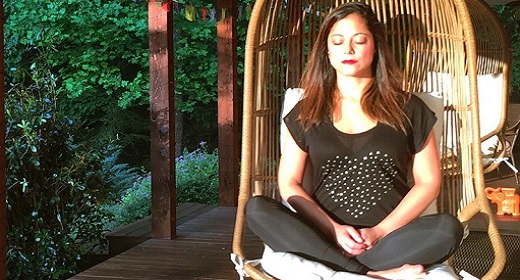Yoga is the dance of every cell with the music of every breath that creates inner serenity and harmony.” – Debashish Mirdha, MD., neurosurgeon & philosopher
So you’re in a mood.
What do you do?
What are your go-to ways to get over it?
Whatever way you choose to work through your moods, here’s one thing to know:
Moodiness isn’t “good” or “bad.”
It’s neutral.
It provides us with clues about what’s going on underneath the surface of our awareness.
They’re like the tip of the iceberg of our inner world – the world of our thoughts, feelings, beliefs, perceptions, fears, etc.
A particularly bad mood can be like a tape caught on loop and overdrive.
Except the tape is our mind and we tend to loop hard when we’re bothered/ pissed/ annoyed/ disappointed/ overwhelmed/ irritated… you get the idea.
So what do we do?
We start breathing.
We tune into the breath and use it to help us navigate the waters of mind and emotions.
Yogic sages have known for thousands of years that the breath is the portal through which we can transform stress and anxiety while accessing a state of inner calm and grounded balance.
Our breathing patterns are intimately tied to our emotions.
Influence one, and you also impact the other.
They form what’s called the Breath-Emotion Loop:
1- Our emotions, thoughts, and moods influence our breathing patterns.
Next time you’re in a mood pay attention to your breathing pattern. You’ll probably notice it’s short, shallow, erratic and/or quick.
Then notice your breathing next time you feel calm, safe, deep in concentration, or at ease. Notice it’ll probably be slower, longer, even-paced, and/or deeper.
2- Our breathing patterns can influence our mood.
If you were to start breathing rapidly taking short and shallow breaths you’ll likely start feeling either awake and alert, or anxious and on guard.
And so, if you begin breathing slowly and deeply you will most probably begin to feel less uneasy and more relaxed.
Paying attention to our breathing patterns can tell us a lot about our mood.
Often times we’re not even aware we’re in a mood until something or someone on the outside reflects it back to us and it’s only then that we realize.
We can become more still and present by consciously controlling our inhales and exhales, and that’s how awareness is born.
And this is also yoga.
You don’t need to use your body or a mat to practice yoga.
You can use only your breath and this is yogic practice (sadhana) too.
The Hatha Yoga Pradipika, a 500-year-old authoritative yogic text states that:
When the breath wanders the mind also is unsteady. But when the breath is calmed the mind too will be still, and the yogi achieves long life.”
Cultivating the habit of daily breath awareness is so effective at stilling the ripples of the mind that even Buddha himself taught this practice to monks.
In particular, the Buddhist Anapanasati Sutta, also known as the “Discourse on the Full Awareness of Breathing,” details Buddha’s instructions on how to use the breath to cultivate calm focus and mindfulness (aka Anapana breathing):
“Breathing in, I know I am breathing in.
Breathing out, I know I am breathing out.
Breathing in, I am aware of my whole body.
Breathing out, I am aware of my whole body.
Breathing in, I calm my whole body.
Breathing out, I calm my whole body”
Mindfully paying attention to our breath means noticing and observing it without judging it and without having the need to change it in any way.
Just noticing the inhales and exhales.
Becoming so awake, aware, and present that we can actually start to feel the inner waves our breath creates.
Bringing full awareness to the sensation and feeling of the breath coming into the nostrils and coming out of the nostrils.
If a thought comes, (which it will, especially if you’re in a mood!) simply bring your attention back to the breath.
Each time the mind wanders, just bring it back to the present moment – the moment where you’re breathing just as you are. Right here, right now.
By cultivating this simple daily habit, we can start to shift the way we feel right now, so we can eventually also shift the way we perceive our reality and our experiences.
This inevitably creates empowering changes in our mood and temperament.
This is how we use our breath and our awareness to get over emotional humps and hurdles more quickly, more efficiently, and more productively.









































